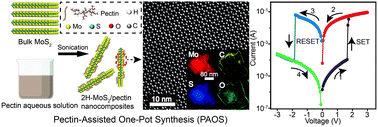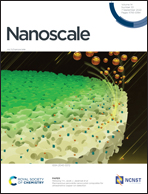Pectin-assisted one-pot synthesis of MoS2 nanocomposites for resistive switching memory application†
Abstract
Developing simple, large-scale, and environmentally-friendly ways to prepare two-dimensional (2D) semiconductive hexagonal phase MoS2 (2H-MoS2) nanocomposites remains a significant challenge. Herein, we propose a facile and green method for preparing few-layer MoS2 nanosheets via a pectin-assisted one-pot synthesis (PAOS), where pectin serves as the surfactant and stabilizer to assist the direct exfoliation of bulk MoS2 into few-layered semiconductive 2H-MoS2 nanosheets in water, as well as a second functional part to produce the 2H-MoS2/pectin nanocomposites simultaneously. Based on the facilely prepared 2H-MoS2/pectin nanocomposites, extraordinary flash memory devices with a typical bistable electrical switching and nonvolatile rewritable memory effect were realized, achieving a low threshold voltage below 2.0 V, a high ON/OFF ratio as high as 5 × 102, and a retention time longer than 104 s. Systematic investigations reveal that the electrical transition is due to the charge trapping and detrapping behaviors of the 2D 2H-MoS2/pectin nanocomposites. These findings through PAOS not only offer a general route for efficiently preparing 2H-MoS2 nanosheets and nanocomposites, but also reveal the great potential of 2D MoS2-based materials in rectifying the electronic properties for high-performance memory devices.



 Please wait while we load your content...
Please wait while we load your content...